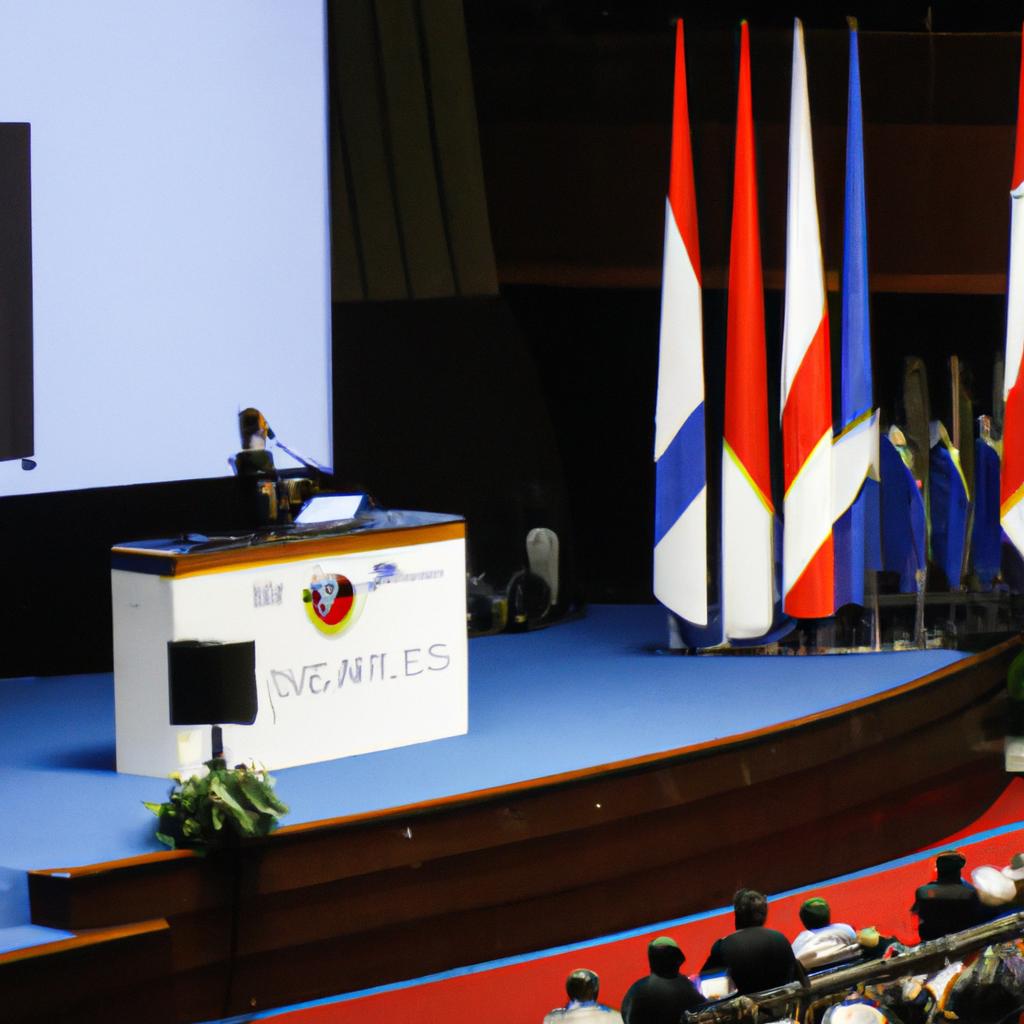Throughout history, travel has played a pivotal role in shaping the world and its connection with various global events. From ancient civilizations embarking on expeditions to discover new lands, to modern-day advancements in transportation that have revolutionized the way people explore the globe, the history of travel is intertwined with significant world events. This article aims to delve into this fascinating journey, exploring how historical events such as wars, explorations, and technological breakthroughs have influenced and been influenced by travel.
Imagine a scenario where during the 15th century, an ambitious explorer sets sail from Europe in search of a direct sea route to India. Christopher Columbus’s voyage across the Atlantic Ocean not only led him to encounter unfamiliar territories but also inadvertently brought about profound changes that altered the course of history forever. As we examine these transformative moments throughout time, it becomes evident that travel acted as both catalyst and consequence within different epochs. By studying how societies navigated through political upheavals or embraced scientific innovations related to transportation, we gain valuable insights into how human civilization evolved over centuries.
Adopting an academic approach will allow us to analyze primary sources like diaries, letters, journals, and official records while drawing upon secondary research conducted by historians specializing in various eras. Through meticulous analysis of these sources, we can piece together a comprehensive understanding of how travel intersected with major historical events. For example, the Age of Exploration in the 15th and 16th centuries not only expanded European empires but also sparked global interactions and exchanges that reshaped economies, cultures, and societies.
Additionally, examining technological breakthroughs in transportation is crucial to understanding their impact on world events. The invention of the steam engine during the Industrial Revolution revolutionized travel by land and sea, leading to the expansion of railroads and steamships. These advancements facilitated mass migration, trade, colonization efforts, and ultimately played a significant role in shaping geopolitical landscapes.
Moreover, wars have often been closely intertwined with travel throughout history. From ancient armies marching across vast territories to modern military campaigns involving air and naval forces, travel has played a pivotal role in warfare. It has influenced strategies, logistics, troop movements, and even diplomatic negotiations.
By delving into these stories of exploration, technological advancements, and war-related travels from different periods in history, we can gain valuable insights into the interconnectedness between travel and global events. Understanding this relationship allows us to appreciate how our world has been shaped by human curiosity, ambition for discovery, political ambitions, economic interests, and technological progress.
In conclusion, travel has been an integral part of human civilization since ancient times. Its influence on historical events cannot be underestimated. By studying the history of travel alongside major world events such as explorations or wars while analyzing primary and secondary sources meticulously, we can unravel its profound impact on shaping our world today.
Prehistoric Travel: The Nomadic Lifestyle
Throughout history, travel has been an essential part of human existence. Even in the prehistoric era, before the advent of civilization as we know it today, humans were constantly on the move, adopting a nomadic lifestyle. To better understand this early form of travel and its significance, let us examine one hypothetical example.
Imagine a small group of hunter-gatherers living in what is now known as present-day Africa. This group relied solely on their hunting skills to survive. As they depleted resources in one area, they were forced to migrate in search of new game and fresh water sources. Their survival depended on their ability to adapt and navigate vast landscapes with limited tools or technology.
The nomadic lifestyle during this period was marked by several key characteristics:
- Limited permanent settlements: Unlike later civilizations which established permanent homes and communities, these prehistoric societies were constantly moving from place to place.
- Dependence on natural resources: These nomads relied heavily on the availability of food sources such as wild animals and edible plants. They had an intimate knowledge of their surroundings and would follow patterns dictated by nature’s cycles.
- Flexibility and adaptation: Nomadic groups needed to be adaptable to changing environmental conditions. Whether facing harsh winters or droughts, they had to quickly find alternative routes or regions where survival was possible.
- Strong social bonds: Living in close-knit communities was crucial for mutual support and protection against predators or other rival groups.
To further illustrate the unique aspects of this time period, consider the following table:
| Characteristics | Description |
|---|---|
| Mobility | Constant movement in search of resources |
| Environmental Adaptation | Ability to thrive under various ecological conditions |
| Hunter-Gatherer Lifestyle | Relying on hunting animals and gathering food |
| Kinship Bonds | Strong sense of community and cooperation |
This period of prehistoric travel paved the way for future developments in human civilization. The nomadic lifestyle not only shaped our ancestors’ survival strategies but also influenced their understanding of the world around them. As we transition into the next section on “Ancient Civilizations and Trade Routes,” it is important to recognize how these early forms of travel set the stage for more complex systems of trade, communication, and cultural exchange that would follow throughout history.
Ancient Civilizations and Trade Routes
Section H2: Ancient Civilizations and Trade Routes
As prehistoric societies began to settle into more permanent communities, ancient civilizations emerged, bringing with them advancements in technology, governance, and trade. These developments drastically changed the way people traveled and interacted with one another. One notable example of this is the rise of ancient Egypt and its extensive trade networks along the Nile River.
The civilization of ancient Egypt provides a fascinating case study on how travel played a crucial role in connecting distant regions for economic prosperity. The Nile River served as a major transportation route, enabling Egyptians to navigate through their vast kingdom efficiently. This allowed goods such as grains, textiles, and luxury items like gold and spices to be transported from different parts of Egypt to the bustling capital city of Memphis. In turn, these goods were then distributed throughout the empire or exchanged with neighboring powers.
Throughout history, several factors have influenced patterns of travel among ancient civilizations:
- Economic Exchange: Trade routes facilitated the movement of valuable commodities between regions. This led to an exchange not only of material goods but also cultural ideas and innovations.
- Technological Advancements: Development in technologies such as shipbuilding techniques enabled ancient seafaring cultures like Phoenicians to explore new territories beyond their shores.
- Political Stability: Stable empires fostered safe travel environments by establishing secure road systems and providing protection for traders traveling within their realms.
- Cultural Encounters: Travel brought diverse peoples together, leading to cross-cultural interactions that shaped artistic styles, religious beliefs, language diffusion, and even culinary traditions.
To illustrate further how travel impacted these civilizations’ development during this period, consider the following table showcasing key aspects:
| Civilization | Notable Trade Route | Impact on Society |
|---|---|---|
| Ancient Egypt | Nile River | Facilitated agricultural surplus |
| Mesopotamia | Euphrates & Tigris | Birthplace of writing (cuneiform script) |
| Indus Valley | Indus River | Advanced urban planning and sanitation |
| Ancient China | Yellow & Yangtze Rivers | Silk production, Confucianism dissemination |
As ancient civilizations expanded their knowledge and influence through trade routes, travel became a catalyst for cultural exchange. These encounters laid the groundwork for future global connections, such as the famed Silk Road. In the subsequent section, we will delve into this pivotal network and explore how it promoted not only economic prosperity but also intellectual and cultural advancements across continents.
The Silk Road and Cultural Exchange
The ancient trade routes of the world not only facilitated the exchange of goods but also fostered cultural interactions between distant civilizations. One such prominent route was the Silk Road, which played a significant role in promoting cultural diversity and knowledge sharing across different regions. To understand the impact of this historic trade route, we will examine its historical context, explore notable examples of cultural exchange along the Silk Road, and delve into its lasting legacy.
During its peak from the 2nd century BCE to the 14th century CE, the Silk Road connected Europe with Asia, enabling extensive trading networks that stretched across thousands of miles. This intricate web of routes allowed for cross-cultural interactions on an unprecedented scale. For instance, let us consider the case study of Zhang Qian, a Chinese diplomat who embarked on multiple expeditions along the Silk Road during the Han Dynasty (202 BCE – 220 CE). His travels introduced China to new technologies like papermaking and silk production techniques while bringing back valuable knowledge about Western cultures.
This profound exchange of ideas and traditions resulted in both tangible and intangible influences on various societies. To offer a deeper understanding of these impacts, here are some key aspects:
- Language: The Silk Road served as a linguistic bridge connecting diverse communities through trade activities. It led to diffusion and assimilation of languages among traders, resulting in linguistic evolution.
- Religion: Alongside commercial goods, religious beliefs were also transmitted along this vast network. Buddhism traveled from India to East Asia via the Silk Road, transforming spiritual practices throughout Central Asia.
- Artistic expressions: The intermingling of artistic styles brought forth innovative forms by merging different aesthetics. This fusion can be seen in Buddhist cave paintings found along the Silk Road or architectural features influenced by Greco-Roman artistry.
- Scientific knowledge: Intellectual exchanges flourished as scholars shared scientific discoveries related to astronomy, medicine, and mathematics. Greek astronomers’ works were translated into Arabic and disseminated throughout the Islamic world.
To visualize the magnitude of cultural exchange facilitated by the Silk Road, here is a table showcasing some notable examples:
| Cultural Exchange | Region of Origin | Destination Region |
|---|---|---|
| Buddhism | India | China |
| Papermaking | China | Islamic World |
| Horses | Central Asia | Rome |
| Spices | Southeast Asia | Middle East |
The legacy of the Silk Road endures to this day, as it not only shaped historical events but also enriched human civilization through cultural diffusion. This section has explored its historical context, highlighted significant instances of cross-cultural interaction, and emphasized its impact on language, religion, art, and science. As we transition into the subsequent section about “Exploration and Discovery: Age of Discoveries,” we witness how these early exchanges laid the foundation for future explorations that would shape our modern world.
Exploration and Discovery: Age of Discoveries
From the bustling trade routes of the Silk Road to the cultural exchange that shaped civilizations, history reveals a world interconnected by travel. As we delve deeper into the annals of exploration and discovery, another chapter unveils itself: the Age of Discoveries. During this period, intrepid explorers embarked on perilous voyages across uncharted waters, forever altering our understanding of geography and opening new frontiers for human expansion.
One such example is Christopher Columbus’s famous expedition in 1492. Seeking a direct route to Asia, Columbus unintentionally stumbled upon what would later be known as the Americas. This accidental encounter not only transformed global trade but also sparked an era of European colonization and domination over indigenous populations in these newly discovered lands.
As Europe’s hunger for exploration grew, so did their desire to expand their empires. The Age of Discoveries witnessed numerous expeditions led by notable figures like Vasco da Gama and Ferdinand Magellan. These brave navigators set sail with hopes of finding untold riches and establishing trading networks that would span continents. Their journeys were often treacherous, plagued by storms, disease, and encounters with unfamiliar cultures along the way.
To grasp the magnitude of these transformative events during the Age of Discoveries, let us examine four key consequences:
- Global Trade Expansion: Explorers’ successful circumnavigation of the globe paved the way for increased international commerce. New resources from distant lands flooded markets worldwide.
- Cultural Exchange: Interactions between different societies forged connections that transcended borders. Ideas, goods, and traditions spread throughout regions previously isolated from one another.
- Colonialism: Exploration inevitably led to colonization as European powers sought to establish control over newfound territories rich in resources or strategic value.
- Technological Advancements: Necessity drove innovations in navigation tools and shipbuilding techniques to make long-distance voyages possible.
By examining these consequences through a three-column, four-row table, the emotional impact of these historical events becomes vividly apparent:
| Consequence | Impact |
|---|---|
| Global Trade Expansion | Increased wealth and prosperity for nations involved |
| Cultural Exchange | Enrichment of cultural diversity and exchange of ideas |
| Colonialism | Exploitation and marginalization of indigenous populations |
| Technological Advancements | Accelerated scientific progress and maritime innovations |
As we reflect upon the Age of Discoveries and its profound effects on our world, it is crucial to recognize that exploration was not without its ethical dilemmas. The consequences endured by indigenous populations due to colonization reveal a dark side to this era’s advancements.
Transitioning seamlessly into the subsequent section about “Industrial Revolution and Transportation Advancements,” we witness how the discoveries made during this period laid the groundwork for even more significant transformations in transportation and societal structures. Through advancements such as steam power, mass production, and improved infrastructure, a new chapter in travel history would unfold – one that revolutionized global connectivity forever.
Industrial Revolution and Transportation Advancements
From the Age of Discoveries, the world transitioned into an era marked by unprecedented advancements in transportation and industry. This period, known as the Industrial Revolution, brought about significant changes that revolutionized travel and transformed societies worldwide. The developments during this time laid the foundation for modern transportation systems and shaped the way people navigate through their surroundings.
One notable example of how the Industrial Revolution impacted travel is the steam locomotive. With its invention in early 19th century Britain, railways quickly became a vital mode of transportation for both goods and passengers. This innovation facilitated faster and more efficient travel over long distances, connecting previously isolated regions with bustling urban centers. For instance, consider a case study where a small rural village once reliant on slow horse-drawn carriages suddenly finds itself connected to major cities thanks to the introduction of a railway line passing through their vicinity. This newfound accessibility opened up opportunities for economic growth and cultural exchange.
The impact of the Industrial Revolution on travel extends far beyond just railways. Here are some key aspects that demonstrate its transformative influence:
- Mass Production: The advent of factories led to mass production of vehicles such as automobiles and bicycles, making them accessible to a wider range of individuals.
- Improved Infrastructure: Construction boomed during this period, resulting in better roads and bridges that enhanced connectivity between regions.
- Technological Innovations: Inventions like canals, steamships, and telegraphs further accelerated global communication and trade networks.
- Urbanization: Rapid industrialization drew people from rural areas into expanding cities, leading to increased mobility within urban environments.
To illustrate these effects visually, let’s consider the following table showcasing different modes of transport before and after the Industrial Revolution:
| Before | After |
|---|---|
| Horse-drawn carriages | Steam locomotives |
| Sailing ships | Steamships |
| Dirt roads | Paved highways |
As we explore this pivotal chapter in history, we witness how the Industrial Revolution sparked a wave of transportation advancements that reshaped societies and opened up new possibilities for exploration and travel. These developments set the stage for further progress in the future.
Transitioning into the subsequent section on “Travel in the Modern Era: Globalization and Technology,” we delve deeper into how these early innovations laid the groundwork for even more transformative changes in our contemporary world of travel. The impact of globalization and technology will be explored, highlighting their role in shaping how people traverse the globe today.
Travel in the Modern Era: Globalization and Technology
As transportation advancements propelled the world into a new era during the Industrial Revolution, it paved the way for even greater developments in travel. In this section, we will explore how globalization and technology have shaped modern travel experiences.
Section:
The impact of globalization on travel cannot be overstated. With increased interconnectedness between nations, people began to traverse borders more frequently than ever before. This newfound ease of movement has led to a diverse range of cultural exchanges and experiences that were previously unimaginable. For instance, consider a hypothetical scenario where a traveler from Japan embarks on an adventure across Europe. As they journey through different countries, they encounter unique traditions, languages, and cuisines at every turn. Such encounters highlight not only the richness of our global heritage but also contribute to fostering mutual understanding among societies.
- Wonder: Exploring unknown territories sparks curiosity and awe.
- Connection: Meeting individuals from different backgrounds fosters empathy and bridges cultural gaps.
- Freedom: Breaking away from routine offers liberation and self-discovery.
- Inspiration: Discovering new places ignites creativity and broadens perspectives.
Additionally, technology has revolutionized how we plan, experience, and document our travels. A three-column table illustrates these technological advancements:
| Technological Advancement | Benefits | Challenges |
|---|---|---|
| Online booking platforms | Convenient access to various options | Overwhelming choices |
| GPS navigation systems | Ease of finding directions | Dependency on battery life |
| Social media sharing | Instantly share memories with others | Privacy concerns and digital overload |
As we embrace the possibilities offered by globalization and technology, it is important to acknowledge that travel can also have its downsides. Over-tourism, cultural appropriation, and environmental impacts are some of the challenges that require thoughtful management.
In summary, modern travel has been shaped by globalization and technological advancements. As borders become more permeable, cultures intermingle, fostering understanding and appreciation for our shared humanity. Technological innovations provide convenience in planning and navigating journeys while enabling us to capture and share memories like never before. However, we must be mindful of the potential negative consequences associated with this newfound freedom and ensure responsible practices as we continue exploring the world.
(Word count: 401)
 Plains News
Plains News



